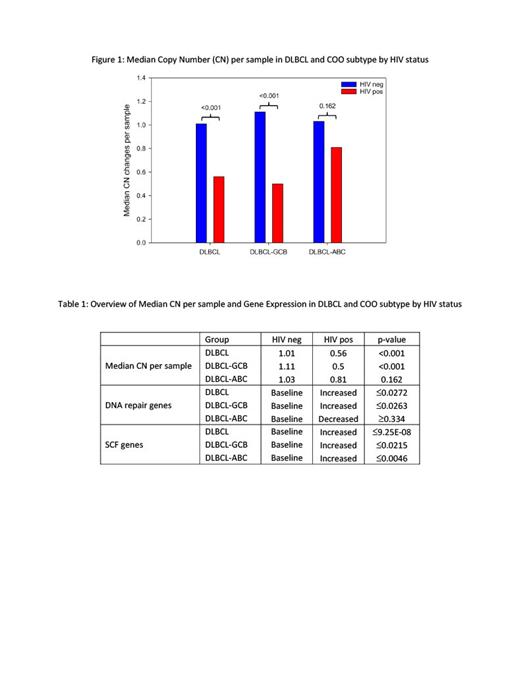Introduction:
Previously we demonstrated that HIV associated diffuse large B-cell lymphomas (DLBCL) of Germinal Center B-cell subtype (GCB) are more proliferative, with enhanced genomic stability and increased expression of DNA repair genes, particularly Fanconi anemia (FA) and homologous recombination (HR) genes compared to their HIV negative counterparts (Maguire et al, 2019). It is unknown if this signature is unique to the GCB subtype or if it is also observed in Activated B-cell (ABC) and Unclassified (UNC) DLBCL. Herein we validate our HIV associated GCB DLBCL findings in a larger independent cohort and report for the first time the aberrational profile of molecularly profiled HIV associated ABC DLBCL compared to their HIV negative counterparts respectively.
Methods:
An independent cohort of 353 DLBCL FFPE cases was assembled, including 125 HIV-DLBCL samples. All samples underwent hematopathological review to confirm diagnosis and determine tumor content. Samples with <60% tumor content were macro-dissected before they were RNA/DNA extracted. Cell of origin (COO) profiles were assessed using the Lymph3Cx molecular assay which can distinguish primary mediastinal B-cell lymphoma (PMBL) like from GCB, ABC and UNC DLBCL (Mottok et al 2018). Copy number (CN) analyses were performed on samples with sufficient DNA (41 HIV neg, 32 HIV pos) using the OncoScan FFPE assay kit and the resulting data analyzed using Chromosome Analysis Suite (ChAS) v4.1 and the multisample viewer module of Reproductive Health Research Analysis Software (RHAS) v1.1. Additional digital gene expression profiling was performed using the Pan-Cancer panel (NanoString, Seattle, WA) customized to include 9 BCL2 family genes for a total of 739 genes and analyzed using the NanoString nSolver Advanced Analysis module.
Results:
GCB, ABC, UNC and PMBL-like proportions were 50%, 30%, 14% and 6% in HIV unassociated (HIV neg) and 50%, 23%, 25% and 2% in HIV pos tumors respectively, confirming both cohorts were GCB-enriched by molecular profiling. PMBL-like cases were excluded from further analyses. OncoScan CN analyses showed that HIV pos DLBCL were significantly less aberrant than HIV neg DLBCL (median CN per sample 0.56 vs 1.01, p<0.001). HIV pos GCB tumors were significantly less aberrant than both HIV neg GCB tumors (median CN per sample 0.50 vs 1.11, p<0.001), and HIV pos ABC tumors (median CN per sample 0.50 vs 0.81, p=0.009). HIV pos ABC tumors were also less aberrant than HIV neg ABC tumors, however, the difference was not significant overall (median CN per sample 0.81 vs 1.03, p=0.162) or for gain/amplifications (median CN per sample 0.38 vs 0.42, p=0.814), but was borderline significant for loss/deletions (median CN per sample 0.31 vs 0.47, p=0.06).
GEP analyses identified Cell Cycle and DNA repair as the top two upregulated pathways in HIV pos GCB tumors compared to HIV neg GCB tumors. In contrast, Cell Cycle and DNA repair were downregulated in HIV pos ABC tumors compared to HIV neg ABC tumors. However, one gene ( RBX1) was identified as significantly upregulated in both pathways in HIV pos GCB (adjusted p-value 0.0215) and HIV pos ABC (adjusted p-value 0.0046) tumors compared to their HIV neg counterparts. A second gene ( SKP1) was also significantly upregulated in HIV pos GCB (adjusted p-value 3.94E-5) and HIV pos ABC (adjusted p-value 0.0031) tumors. Together RBX1 and SKP1 encode the two principal functional subunits of the SKP1, CUL1, F-box protein (SCF) complex which is part of the ubiquitin proteasome system (UPS) and has been reported as essential for maintaining genome and chromosome stability (Thompson et al 2021).
Conclusions:
These results demonstrate that HIV pos DLBCL tumors are less aberrant than their HIV neg counterparts irrespective of COO subtype. However, the degree of genomic stability differs by COO, with HIV pos GCB tumors being more genomically stable than HIV pos ABC tumors. Although both have enhanced expression of UPS related SCF genes ( RBX1, SKP1), only HIV pos GCB tumors have enhanced expression of key DNA repair genes as well including Fanconi Anemia ( BRCA2/FANCD1, FANCL) and mismatch repair ( MSH2, MSH6) genes (adjusted p-values of ≤ 0.0263). Given the reported role of SCF in genomic stability maintenance, the HIV pos COO CN differences could be due to the contributions of both DNA repair and SCF mechanisms in HIV pos GCB and mainly SCF mechanisms in HIV pos ABC tumors.
Disclosures
Vega:Geron: Research Funding; Allogene: Research Funding. Pileri:CELGENE: Other: Advisory board; ROCHE: Speakers Bureau; NANOSTRING: Other: Advisory Board; Stemline: Speakers Bureau; Diatech Pharmacogenetics: Consultancy; Beigene: Research Funding, Speakers Bureau; Eli Lilly: Speakers Bureau. Rimsza:Roche: Other: Consulting; NanoString: Other: Licensed intellectual property.


This feature is available to Subscribers Only
Sign In or Create an Account Close Modal